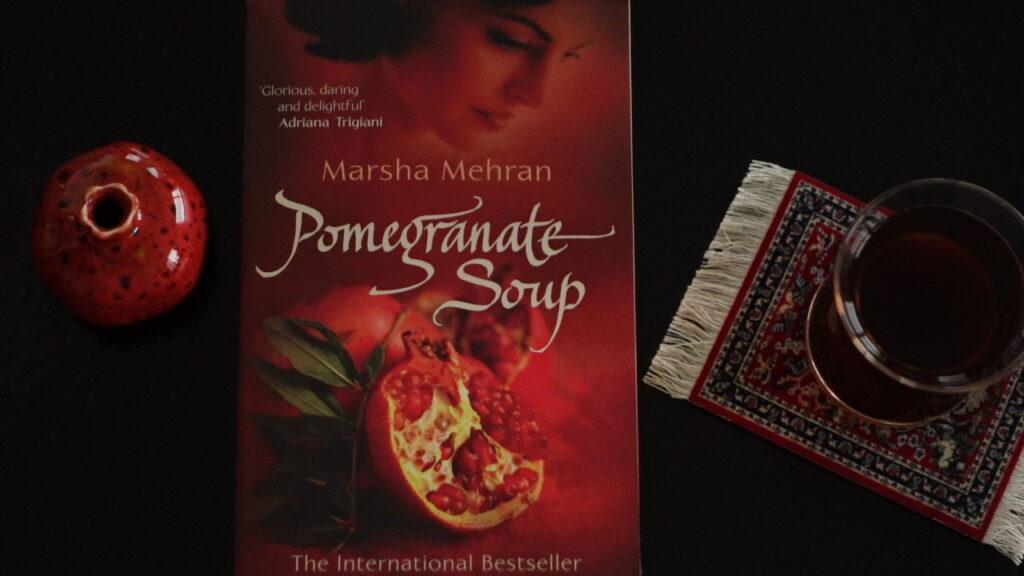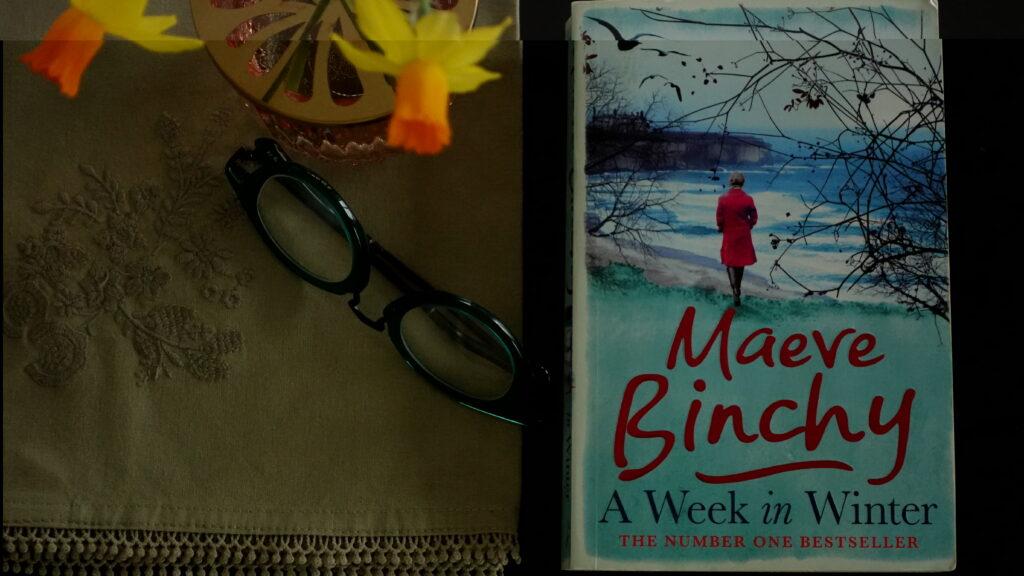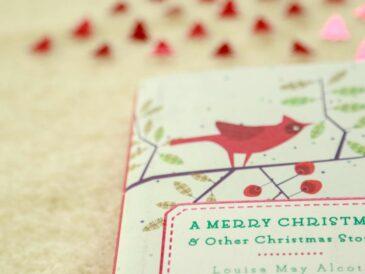Hello friends, and welcome to a March celebration that connects people, continents and cultures !
If you’ve been here for a while, you know that I love a good excuse to celebrate and discover, and thankfully, there are feasts around the world for practically every day of the year. Some are new additions to my repertoire, others are good friends I like to meet up with every year. And this Spring, I’m building a three day bridge between the Irish St Patrick’s Day of March 17th and the Persian New Year Nowruz of March 20th. That’s right, Ireland and Iran, together for a ritual of reading like no other.
You might wonder how this all began, and predictably enough, it all started with a book : Marsha Mehran’s bestselling novel Pomegranate Soup.
Two years ago, I made a Nowruz dedicated video where I spoke at length about my love of the Persian culture, and if you haven’t seen it, you can pause now and follow the link to watch it. My reading on this subject never stops, and so, I find myself drawn to the Iranian shelf of my bookcase each Spring, as we approach the 20th of March, date of the Persian New Year.
Marsha Mehran’s debut novel tells the story of three Iranian sisters that have taken refuge in a small coastal Irish town, where they plan on building a new life. Leaving behind a country ravaged by revolution and extremes, they carry a heavy emotional burden, but find comfort in their love of food and open up a Persian café that will prove to shake things quite a bit in this traditional Irish community. Each chapter of the novel revolves around a new recipe, taking the reader through a variety of typically Iranian flavours. Some I have recognised, others I have discovered, each one taking me further more into the enchanted world of subtlety and delight. I loved how beautifully she created typical characters for each of the two cultures : the prudent, suspicious Iranian women, proud of their heritage yet not willing to let anyone into their safe space, and the conservative, family oriented Irish people, wary of anything foreign that might disrupt the order of their world. The meeting point of these two universes is found in a bite of delicious pastry or a sip of the famous Iranian tea. A novel that doesn’t surprise the reader, with the exception of a few triggers of domestic violence, yet carries its value in the humanity it underlines. The willingness to know one another, to respect and to share common values, just like good food, knows no borders, needs no translation and brings universal joy.
The pomegranate soup sounded tempting, yet for this Spring ritual I longed for greenery, and it so happens it worked out great for the Irish hint as well. So I made a Persian thick soup, a favourite throughout the Nowruz week long celebration, called ash reshteh. The three pillars of this soup are the beans, the surprising amount of aromatics and green leaves, and the noodles that give its name, reshteh. I took the shortcut and used only canned beans, the traditional lentils, chickpea and kidney beans, as well as some cannelini white beans that I ended up adding off camera. As for the herbs, traditionally you would use parsley, chives and coriander leaves, but I switched for dill since I’m genetically inclined to find coriander disturbing. The largest bunches you could find, I would say that in the end I had about 6 or 7 cups full of chopped up herbs. And of course, fresh spinach leaves, a bit more than the herbs but not by much, about 8 or 9 cups. Nicely caramelised onion, some turmeric, salt and pepper, then I added the greens and water, and let them boil for 20 minutes. The spinach was still a bit chunky so I partially blended the soup, not too much though. Then in with the beans and the noodles. If you don’t have Iranian grocers nearby, you can use linguini instead.
The toppings are half the magic in this recipe, and even though I skipped one, the result was fantastic. Kashk is a thick paste made from whey, typically Iranian, with a strong smell of mature cheese resembling a good parmesan. You might remember me using it in the Nowruz video for the aubergine dip, and now, I’m doing the same, only diluting it with saffron essence instead of water. Then the star of any show, fried dry mint, made by tossing the ground leaves into hot oil and taking it instantly off the heat. The third one would be fried onion, but I don’t always make it. This is the perfect bowl for early Spring. Plant based, green, aromatic, and just a tad exotic for me.
Now that I found myself in Ireland, I went looking for a beloved author, someone to bring the essence of the Irish people into my world. And the choice was obvious : Maeve Binchy’s number one bestseller A week in winter. I had no idea what to expect, and I confess the cover made me think of romance, but since the whole point of this adventure was to discover something new, I dove into the novel and came out on the other side with a smile on my face. This is a story with many characters and narrative angles, as we meet the owner of Stone House bed and breakfast, her life story and the transformations that took her from being a naive Irish girl to business owner and pillar of her community. Then each and every one of the guests that come to Stone House for its inaugural week. Their stay in this beautiful authentic Irish manor on the West coast turns out to be transformative for all of them, and through their stories, Maeve Binchy does what she knows best : sketch out characters and life stories that inspire all of us. There is a beautiful breadcrumb trail of optimism throughout the novel, for some this might sound like fast-food literature, but I am an advocate for happy endings, because we need to be inspired by good. As much as I appreciate militant literature, books that defend fundamental causes by bringing uncomfortable truths into the spotlight, we cannot live off this alone. Our spirit needs to be lifted by stories that help us believe there can be a happy ending. If you agree, this book is for you.
The pages guided me to the Irish Cultural Centre in Paris, for a quick leap in time and space, as I discovered photographs of 19th century Ireland, recently recoloured for a beautiful album. I was surprised by the intensity of their gaze, as if they knew how that one second that captured and instant of their lives, would make them immortal. You can find the album online, I’ll leave a link below.
And of course, I couldn’t leave this Irish haven without a visit to the Chapel of Saint Patrick, the building block of the catholic Irish community in Paris.
Now you cannot have an Irish feast without some Guinness, even if you’re incapable of properly cracking open a can. Today’s mission is a Guinness chocolate cake with a malty cream cheese frosting. These days, baking seems to be a grounding ritual for me. No matter the weather or the breaking news, I appear to go into a meditative state whenever butter, sugar or flour are involved. This is a simple, no fuss recipe, made delicious by the enormous quantity of butter, and of course, the perfect balance between the cocoa and the dark beer. With my remaining liquid, I made a thick and decadent Guinness syrup, that flavoured my cream cheese to perfection. A little taste of Ireland to honour Saint Patty and bring the characters of the novel closer to me.
Now when I say cake, I also say tea time, and it so happens that the two countries I’m taking inspiration from today, are both famous for their love of tea. The techniques are not identical, but they agree on one thing : black tea as a staple for all day long refreshment. So I’m blending the two by brewing a cup of Irish Afternoon Tea, then serving it the Iranian way, with saffron infused sugar. In some parts of Iran, it’s customary to keep a piece of sugar between your teeth and drink your tea by letting it pass through it, but I find these traditional candied sugar sticks simply irresistible. A quick research online comforts me in this choice of beverage for such an unexpected duo of cultures : they say that Iranians start their day with a cup of tea, and end it with one just before bed, with many more in between, all throughout the day. As for the Irish, their tea habits range anywhere from 4 to 6 cups a day. So even if these two countries seem to have little in common, it’s always surprising and reassuring to see how similar we are on this planet.
For this Persian New Year, I wanted to go back to a special book that speaks of Iran like no other. You might remember me reading an Italian scented memoir a few summers ago, Kamin Mohammadi’s Bella Figura that I absolutely adored. But the first book that introduced me to this Iranian born, British adopted, worshiper of Italy, was her memoir The Cypress Tree. In all the books I’ve read, trying to better understand this ancient civilisation, the passion always seemed to overcome reason. Its complicated history of modern times has made writers take sides. You can imagine my surprise when in found, not in an essay but in the memoirs of an Iranian woman, a more objective point of view than in many other writings. Kamin’s self-proclaimed love letter to Iran, has both the tender voice of a child remembering moments of family gatherings, and the precise viewpoint of a journalist that can only gather facts. This is a perfect starting point for anyone who wishes to learn both the history of Iran as a country, and the exceptional character of its people.
Page after page, I felt the gardens of Shiraz getting closer and closer. And if a Persian rose can only exist in my imagination, reality has offered me an unexpected gift : a showcase of ancient texts and calligraphy hosted by the Islamic Art Department of the Louvre. The art of Islamic calligraphy is a study in precision and beauty, and I felt privileged to see with my own eyes, such delicate testimonies of the excellence humans are capable of. Some pages are transcripts of the Coran, but the great majority are Persian poems or pages from famous tales, like the 12th century Treasury of Mysteries by the great poet Nizami. Or the 11th century Book of Kings, written by the one of the undisputed giants of Persian literature, Ferdowsi. For me, miniatures are amongst the greatest treasures we have as humans. They sublimate the beauty of words on pages of infinite elegance. I would like to imagine this as the mirror of our global civilisation. As if a miniature of a Persian epic poem, or of a medieval song of French troubadours for that matter, could suffice to understand the most exquisite sentiments we can express.
My month of March was dedicated to many symbols. I read three books by three exceptional women, I got to meet both Irish fairies and their Iranian cousins, the persi, I drank delicious tea and most importantly, I celebrated the beauty of each culture. Once again, my books inspired a ritual of imaginary travel and unforgettable discoveries. I hope you’ve enjoyed my Irish-Iranian adventure. Happy Saint Patrick’s day, and Nowruz Mobarak !
Until next time, enjoy your reading and your rituals.














